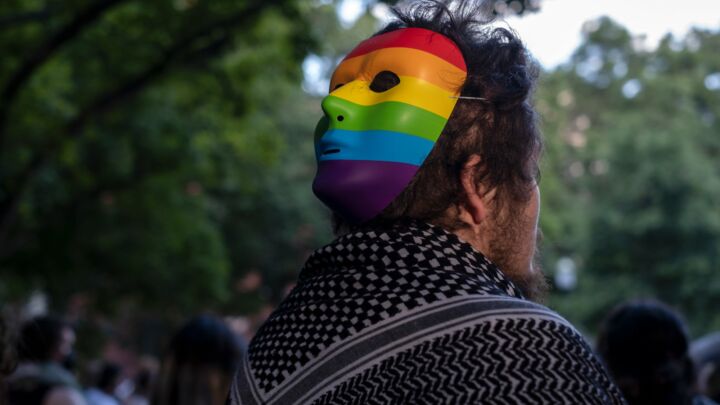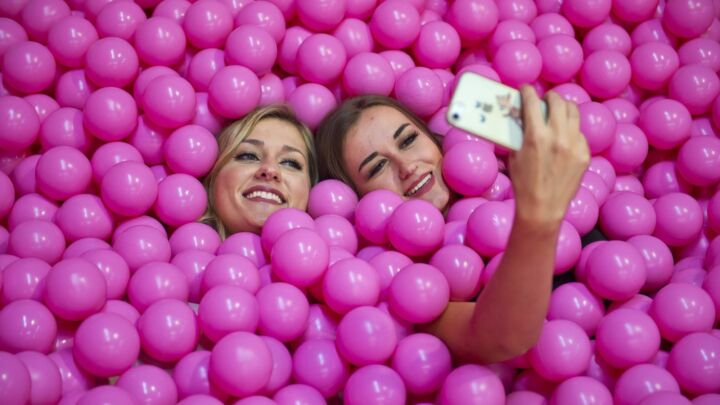
Long-read
Homophobia in drag
Transgender ideology has breathed new life into a dark, old prejudice.
Want to read spiked ad-free? Become a spiked supporter.
When I was a young boy, I loved spending the night at my grandmother’s house. There, I could stay up as late as I wanted, and in the morning, there would always be Cinnamon Toast Crunch for breakfast. But the best part was raiding the closet in her basement, which was full of the gowns she had worn in the 1960s and 1970s – frilly pink and purple confections made of lace, chiffon and silk. I would put them on and watch The Golden Girls, sophisticatedly sipping Coke from a wine glass.
When I was nine, my dad bought a video camera, a giant monstrosity that my siblings and I struggled to balance on our shoulders while we filmed home videos. Alone, I’d prop the camera on the coffee table and record myself modelling various outfits, explaining to the camera why this plaid shirt went with these cargo shorts, or why this teal Starter jacket complemented these acid-washed jeans so perfectly. I captured on camera the dance I had painstakingly choreographed to Marky Mark and the Funky Bunch’s ‘Good Vibrations’.
As a kid, I followed my two older sisters around like a shadow, mimicking their mannerisms – the way they tucked loose strands of hair behind their ears when they were concentrating on their maths homework; the way they jutted their hips whenever they were talking to cute boys. Like them, I was a naturally athletic kid. My favourite sport was lacrosse, but I much preferred to play with the girls instead of the boys. The boys were quick to push and shove, and they loved to whack each other with their aluminium sticks. Girls relied more on their speed, their reflexes and the skills they’d honed to keep the ball securely cradled in the shallow mesh of their wooden sticks.
I grew up in a fundamentalist Christian community – most people would call it a cult. From kindergarten to the sixth grade, I attended the community’s tiny school. Because enrollment was so low, there was no in-crowd, no separate cliques of jocks and geeks. In retrospect, I’m sure my classmates and especially my teachers noticed my gender-nonconformity – all of my home videos prove that it was glaring – but it went largely ignored. All that mattered was that we were good Christians, that we loved Jesus and evangelised God’s Word to as many people as possible. When I learned about homosexuals in Bible class, or about AIDS (which we were told God had created to punish homosexuals for their sins), I didn’t think for a moment that I was one of them. Sure, my first real crush, when I was 11, had been on a boy – Elijah Wood, an actor about my age whose performance in the 1994 B-movie, North, had captured my heart. But at the time, before sexual maturity, I mistook the longing I felt for Elijah with the more sanitised desire to simply keep his company and be his best friend. I indiscriminately absorbed all of the lessons I learned about homosexuals, as if they were and would always be irrelevant to my life.
The summer after my sixth-grade year, my family left the community and we moved to a neighbouring town. I began seventh grade in a large public school, where there was definitely an in-crowd. My new classmates wasted little time informing me how unacceptable it was for a boy like me to behave the way I did – the way I enunciated my s-words, the way I brushed my auburn hair, which I had highlighted the previous summer with Sun-In. They called me a faggot, delivered me notes that said everyone knew my ‘dirty little secret’. They asked me frequently, ‘Are you a boy or a girl?’. Well, of course I was a boy, I would respond, trembling.
Meanwhile, I was beginning to sexually mature; I was soon developing crushes that inspired more than just a desire to keep a boy’s company. With horror, I realised that I might actually be what the kids were calling me – which, I knew in my bones, guaranteed me a tragically short life and a one-way ticket to hell. That, after all, was what the old form of homophobia entailed. Self-loathing.
To survive the onslaught, I defeminised myself. I lowered my voice, started wearing baggy jeans and sweatshirts, cut the highlights out of my hair, and replaced my Mariah Carey CDs with Nirvana. Soon, the fear and the anxiety became too much to bear, and the only refuge I found was in alcohol and drugs.
In high school, with each passing year, my drug use got worse. After graduation, I lasted one semester in college before dropping out. Two months later, at the age of 19, I had my first of several stays in a local psychiatric ward. I was delusional, addicted to drugs and suicidal.
It was during my second stay in the psychiatric ward that I was introduced to a 12-step programme, which was how I would eventually get sober in my early twenties. It was slow-going in the beginning of my sobriety to accept my homosexuality. I began to reconnect with the young boy I had once been, the boy whose interests expanded beyond what was typical for males. I experimented with bronzer and mascara, and got French manicures and pedicures.
Engaging in these behaviours felt liberating for a while, but eventually the novelty wore off. In fact, they started to feel performative. I realised I didn’t need those things to be my authentic self. My ideas, my voice, the way I treat other people – these are the things that make me the person I truly am.
In 2011, when I was 28, I fell in love with a man. The following year, I joined the fight for marriage equality. After we won that campaign, I knew I wanted to become a gay activist. I wanted to help create a world in which feminine boys and butch girls could exist peacefully in society. A world in which gender-nonconforming people were accepted as natural variations of their own sex. Minorities, sure, but real and valid nonetheless.

The trans question
In 2017, at the age of 33, I enrolled at Columbia University, New York to complete my undergraduate degree. There, I was shocked to discover how gay activism had evolved since marriage equality became the law of the land. The focus was now entirely on personal pronouns and on being ‘queer’. My classmates labelled me ‘cis’, short for cisgender. I didn’t even know what it meant. All I knew was that they called me ‘cis’ in the same cadence that the seventh graders had called me ‘fag’.
Soon, I learned about nonbinary identities, and that some people – many people – were literally arguing that sex, not gender, was a social construct. I met people who evangelised a denomination of transgenderism that I had never heard of, one that included people who had never been gender dysphoric and who had no desire to medically transition. I met straight people whose ‘trans / nonbinary’ identities seemed to be defined by their haircuts, outfits and inchoate politics. I met straight women with Grindr accounts, and listened to them complain about the ‘transphobic’ gay men who didn’t want to have sex with women.
All around me, it seemed, straight people were spontaneously identifying into my community and then policing our behaviours and customs. I began to think that this broadening of the ‘trans’ and ‘queer’ umbrella was giving a hell of a lot of people a free pass to express their homophobia.
At Columbia, I took classes on LGBT history, but much of that history was delivered through the lens of queer theory. Queer theorists appropriate French philosopher Michel Foucault’s ideas about the power of language in constructing reality. They argue that homosexuality didn’t exist prior to the late 19th century, when the word ‘homosexual’ first appeared in medical discourse. Queer theorists proselytise a liberation that supposedly results from challenging the concepts of empirical reality and ‘normativity’. But their converts instead often end up adrift in a sea of nihilism. Queer theory, which has become the predominant method of discussing and analysing gender and sexuality in universities, seemed to me to be more ideological than truthful.
In my classes on gender and sexuality in the Muslim world, however, I discovered something else, too. I learned about current medical practices in Iran, where gay sex is illegal and punishable by death, and where medical transition is subsidised by the state to ‘cure’ gays and lesbians who, the theocratic elite insists, are ‘normal’ people ‘trapped in the wrong bodies’. I privately drew parallels between the anti-gay laws and practices of Iran and what I saw developing in the West, but I convinced myself I was just being paranoid.
Then, I learned about what was happening to gender-nonconforming kids – that they were being prescribed off-label drugs to halt their natural development, so that they’d have time to decide if they were really transgender. If so, they would then be more successful at passing as the opposite sex in adulthood. Even worse, I learned that these practices were being touted by LGBT-rights organisations as ‘life-saving medical care’.
It felt like I was living in an episode of The Twilight Zone. How long were these kids supposed to remain on the blockers? And what happens in a few years, if they decide they’re not ‘truly trans’ after all, and all of their peers have surpassed them? Are they seriously supposed to commence puberty at 16 or 17 years of age? These questions rattled my brain for months, until I learned the actual statistics: nearly all children who are prescribed puberty blockers go on to receive cross-sex hormones. Blockers don’t give a kid time to think. They solidify him in a trans identity and sentence him to a lifetime of very expensive, experimental medicalisation.
I wondered how different these so-called trans kids were from the little boy I had been. Obviously, I grew up to be a gay man and not a transwoman. But how could gender clinicians tell the difference between a young boy expressing his homosexuality through gender nonconformity, and someone ‘born in the wrong body’? I decided to dig deeper into the real history of medical transition.
Medicalising homosexuality
What I learned validated all of my worst fears. I learned that for decades after their invention, synthetic ‘sex hormones’ were used by doctors and scientists who sought to ‘cure’ homosexuality, and by law enforcement to chemically castrate men convicted of committing homosexual acts.
I learned about actress and singer Christine Jorgensen, one of the first people in the US to become widely known for having ‘sex-reassignment’ surgery in the early 1950s. Jorgensen may now be celebrated by the modern ‘LGBTQIA+’ community as a trans icon, but he seemed more concerned with escaping his homosexuality, which he said was ‘deeply alien to my religious attitudes’. As Jorgensen put it, ‘I identified myself as female and consequently my interests in men were normal’.
I learned that of the first adolescents to be treated for gender dysphoria (or what was then called ‘gender identity disorder’) with puberty blockers and cross-sex hormones in the 1990s and early 2000s, the vast majority were homosexual. And I learned that these studies inform current ‘gender-affirming care’ practices.
Soon, I met detransitioned gay men who had sought an escape from internalised and external homophobia in a transgender identity. They continue to suffer severe post-surgical complications, years after their vaginoplasties.
I began to fear we had reached a point of no return a couple of years ago, during a conversation I had with a supposedly ‘progressive’ friend. I told her that, if I had been a young boy now, I likely would have been prescribed puberty blockers and gone on to medically transition. ‘And you don’t think you would’ve been happy as a transwoman?’, she asked me. Her question left me speechless. I couldn’t find the words to state the obvious: that I am a gay man, not a transwoman; that statistics tell me my medical transition may not have been successful; and that I would suffer severe medical complications. In any case, if I had transitioned, I wouldn’t be living an authentic life. After all, isn’t that what this is supposed to be about? Living authentically?
Sylvester, an androgynous disco icon of the 1970s and 1980s, was once asked what gay liberation meant to him. He answered, ‘I could be the queen that I really was without having a sex change or being on hormones’. Perhaps I belong in an earlier era, when newly liberated gays and lesbians rebelled against the medical and psychiatric experiments they had long been subjected to. Perhaps my early aspiration of expanding what it means to be a boy or a girl was nothing but a pipe dream. In Europe, there is hope that these medical experiments will cease, and that gay and lesbian adolescents will be spared from a lifetime of medicalisation. But in the US, nearly eight years after same-sex marriage became the law of the land, it is full-steam ahead with these homophobic practices.
For voicing my concerns about gender-affirming care for minors, I have been called a transphobic bigot. If that’s what speaking out against the medicalisation of homosexuality makes me, then so be it.
Ben Appel is a writer based in New York. His forthcoming memoir, Cis White Gay: The Making of a Gender Heretic, will be published by Post Hill Press.
Pictures by: Getty.
Celebrate 25 years of spiked!
A media ecosystem dominated by a handful of billionaire owners, bad actors spreading disinformation online and the rich and powerful trying to stop us publishing stories. But we have you on our side. help to fund our journalism and those who choose All-access digital enjoy exclusive extras:
- Unlimited articles in our app and ad-free reading on all devices
- Exclusive newsletter and far fewer asks for support
- Full access to the Guardian Feast app
If you can, please support us on a monthly basis and make a big impact in support of open, independent journalism. Thank you.






Comments
Want to join the conversation?
Only spiked supporters and patrons, who donate regularly to us, can comment on our articles.